If you see LMK in a text, it means “let me know,” which is a quick way to ask someone for updates, plans, or confirmation. It’s commonly used in casual chats to save time and keep conversations efficient. People often use it when making arrangements or requesting quick responses. To understand more about how this abbreviation fits into digital communication and what variations exist, keep exploring further.
Key Takeaways
- LMK is an abbreviation for “let me know,” used in informal texting to request updates or responses.
- It originated from digital slang to facilitate quick, efficient communication in casual conversations.
- Commonly used when making plans, checking availability, or seeking confirmation from friends or colleagues.
- Variations include “let me know,” “keep me posted,” or “holler at me,” depending on tone and context.
- Typically avoided in formal communication to maintain professionalism; more formal phrases are preferred in official messages.
The Origin of LMK in Digital Communication

The abbreviation LMK, meaning “let me know,” likely emerged from the need for quick and efficient communication in digital spaces. Its origins can be traced to the broader digital slang evolution, where users sought concise ways to share information. Texting abbreviation origins often reflect a desire to save time and keystrokes, especially when messaging on limited-character platforms like SMS. LMK gained popularity as people looked for simple shorthand to prompt responses or updates. Over time, it became a common part of online communication, especially in casual conversations. Its brevity makes it a practical choice for quickly requesting information without elaborate phrasing. This evolution highlights how digital slang adapts to meet the fast-paced nature of modern digital interactions. Additionally, such abbreviations are influenced by the need for efficient communication, which is a key aspect of digital language development.
Common Contexts Where LMK Is Used

You might often see LMK in casual conversations when someone wants you to provide updates or confirm plans quickly. In digital slang, LMK is common in texting etiquette to keep conversations efficient. It’s often used in various contexts, such as making plans, checking availability, or requesting decisions. For example, someone might say, “Are you free tonight? LMK,” prompting a quick response. Here’s a quick look at typical uses:
| Context | Example |
|---|---|
| Planning social events | “Dinner at 7? LMK.” |
| Confirming availability | “Can you send that report? LMK.” |
| Making quick decisions | “Should I buy it? LMK.” |
| Checking in on progress | “Finished yet? LMK.” |
Using LMK helps maintain a smooth flow in texting etiquette, especially in informal chats.
Alternative Ways to Say LMK
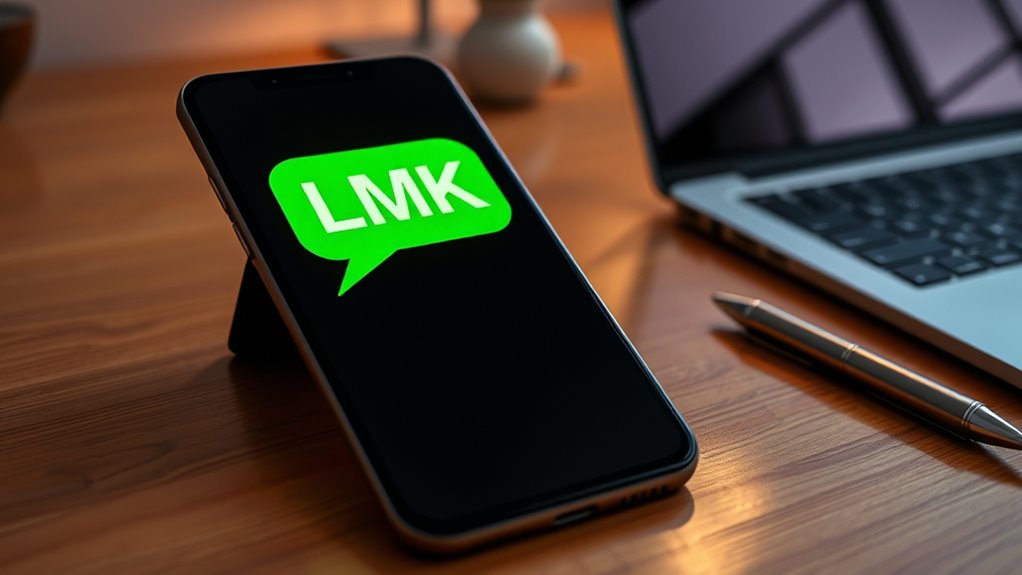
Looking for alternative ways to say LMK can help keep your messages fresh and suited to different tones or contexts. It also shows your awareness of current digital communication trends and proper text messaging etiquette. Here are some options to contemplate:
- Let me know
- Keep me posted
- Holler at me
- Update me
- Ping me
Using these alternatives can make your messages more varied and appropriate for formal or casual conversations. They also help convey your intent clearly without overusing abbreviations. Whether you’re chatting with friends or communicating professionally, switching up your phrases keeps your digital communication engaging and respectful of modern etiquette. Incorporating generative AI in storytelling techniques can further enhance how you craft engaging messages and responses. This approach ensures your messages are both effective and culturally aware.
How to Respond When Someone Uses LMK
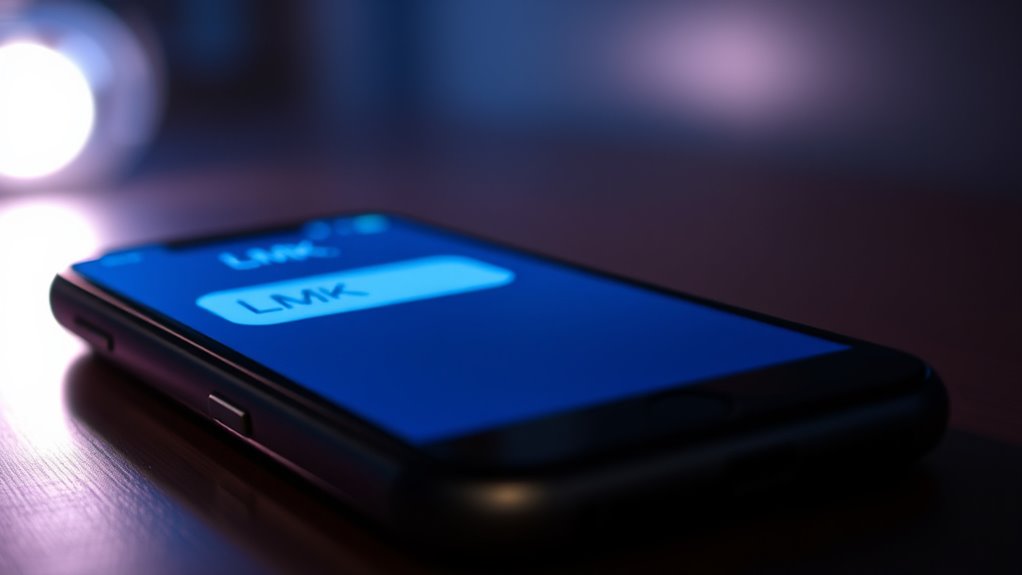
When someone sends you LMK, it’s helpful to clarify what they’re asking and state your intentions clearly. You can also suggest a specific time or plan to keep things simple. Always respond politely to maintain good communication and avoid misunderstandings. Being aware of appetizer options can also help you make engaging conversation if the topic arises.
Clarify Your Intentions
If someone uses LMK in a message, it’s important to clarify your intentions so there’s no misunderstanding. With digital literacy evolving alongside slang, it’s easy to misinterpret messages. To avoid confusion, consider these tips:
- Ask for specifics if you’re unsure about the request or context.
- Use clear language to explain what you need or want.
- Confirm the details to ensure both of you are on the same page.
- Recognize that slang like LMK can have different meanings depending on the situation.
- Stay open to questions to promote effective communication.
- Be aware that narcissistic communication patterns may influence how messages are conveyed and understood.
Offer a Specific Time
Once someone asks you to LMK a specific time, respond by offering a clear, concrete option rather than a vague or open-ended reply. Suggesting meeting times that work for you makes scheduling appointments easier and more efficient. Instead of saying, “I’m free sometime,” specify a day and time, like “How about 3 p.m. on Thursday?” or “Would Friday morning work for you?” This approach helps avoid confusion and speeds up the planning process. Be considerate by offering a couple of options if possible, giving the other person flexibility. Clear, direct responses show you’re interested and prepared, making it easier to coordinate your schedules and finalize plans quickly. Additionally, considering seasonal variations can help determine the best time for outdoor activities or meetings.
Keep Responses Polite
How should you respond politely when someone asks you to LMK a time? Using good texting etiquette shows respect and keeps communication smooth. Keep your responses polite by acknowledging their request and providing a clear answer. Remember, digital slang like LMK is casual, so maintain a friendly tone. To stay courteous, consider these tips:
- Thank them for reaching out
- Confirm the details clearly
- Use polite language like “please” or “thank you”
- Avoid abrupt or short replies
- Express enthusiasm or willingness to help
- Be adaptable and considerate of family values when scheduling or discussing plans
Responding kindly encourages positive interactions and keeps your digital communication respectful. When you’re polite, even informal messages like LMK foster good relationships and clear understanding. Staying courteous in your responses ensures everyone feels valued in your conversations.
Variations and Similar Abbreviations
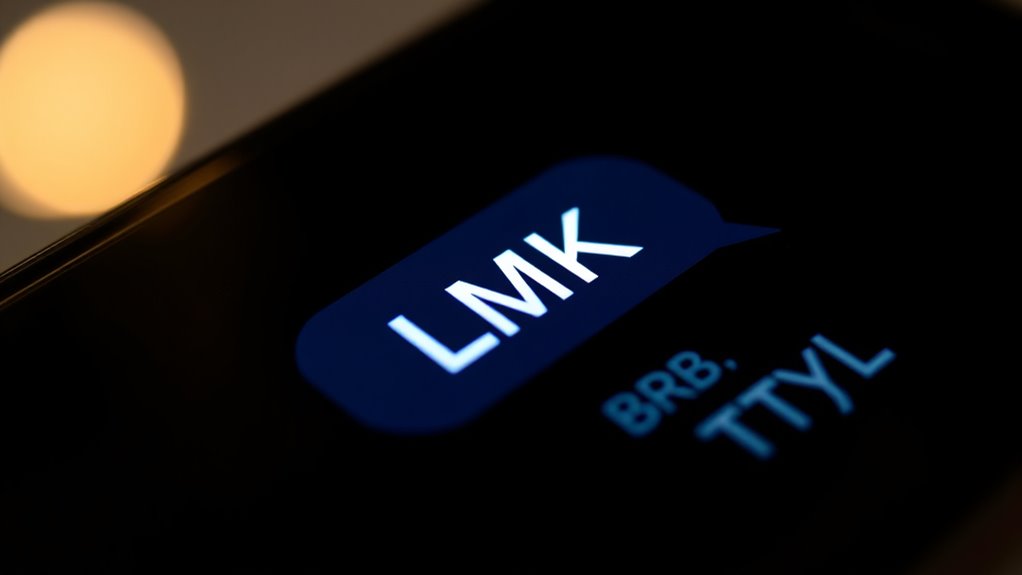
You might notice different abbreviations that serve similar purposes, like “ASAP” or “FYI,” depending on the situation. Some versions are more formal, while others are casual or playful, which can change how your message is received. Understanding these variations helps you choose the right abbreviation based on the context and your relationship with the recipient. Additionally, being aware of cookie consent management and privacy considerations can influence how you communicate sensitive or official information.
Common Alternative Abbreviations
Have you noticed other abbreviations that resemble LMK in text messages? Many digital slang terms follow similar patterns, reflecting current abbreviation trends. These shortcuts help keep conversations quick and informal. Here are some common alternatives:
- BTW (By The Way)
- ASAP (As Soon As Possible)
- ICYMI (In Case You Missed It)
- TL;DR (Too Long; Didn’t Read)
- TTYL (Talk To You Later)
These abbreviations are part of evolving digital slang, making communication faster and more efficient. Recognizing these variations helps you stay current with abbreviation trends and understand other people’s messages more easily. They often serve different purposes but share the goal of streamlining digital conversations. Additionally, understanding modern communication shortcuts can improve your ability to interpret and participate in casual digital exchanges.
Formal vs. Informal Use
Are there clear differences between using abbreviations like LMK in formal versus informal contexts? Yes, in informal settings, LMK is common, quick, and friendly, often used among friends or close colleagues. However, in formal communication, such abbreviations are typically avoided, as they can seem unprofessional or casual. Cultural differences and regional usage also influence this distinction; in some regions, abbreviations like LMK are more accepted even in semi-formal messages, while elsewhere, they’re strictly reserved for casual chats. Variations and similar abbreviations, like “let me know,” are often used interchangeably, but understanding your audience helps determine the appropriateness. Overall, the context and cultural expectations shape whether you should use LMK or opt for a more formal phrase. Recognizing appropriate communication styles ensures your message aligns with the situation.
Contextual Variations
Variations of abbreviations like LMK and similar phrases often reflect different cultural and regional preferences. In casual conversations, you might see variations like “L8R” for later or “ASAP” for as soon as possible, which suit informal tones. In professional emails, abbreviations tend to be more conservative, with some replacing LMK with phrases like “Please let me know” or “Kindly confirm.” To keep your communication clear, consider these points:
- Use simple abbreviations in casual chats to save time
- Avoid slang in formal or professional emails
- Choose more explicit phrases when clarity is essential
- Be aware that regional slang influences abbreviation choices
- Match your language style to the context and audience
- Juice Cleanse benefits can influence how you communicate about health topics in different settings
Understanding these variations helps you communicate effectively across different settings.
The Evolution of Text Language and Abbreviations

Ever wonder how text language and abbreviations have transformed communication over the years? It all started with digital slang, which evolved alongside technology’s rapid growth. In the early days of texting, people created abbreviations to save time and characters, giving birth to the abbreviation history we see today. As mobile phones became more popular, abbreviations like “LOL,” “BRB,” and “LMK” emerged, making conversations quicker and more casual. Over time, these shortcuts became part of everyday language, especially among younger generations. This evolution reflects how communication adapts to new platforms, prioritizing speed and efficiency. Additionally, understanding compatibility factors can help clarify how people connect and communicate across different contexts. Today, the language continues to grow, influenced by social media and instant messaging, shaping a dynamic and ever-changing digital slang landscape.
Tips for Understanding Internet Slang
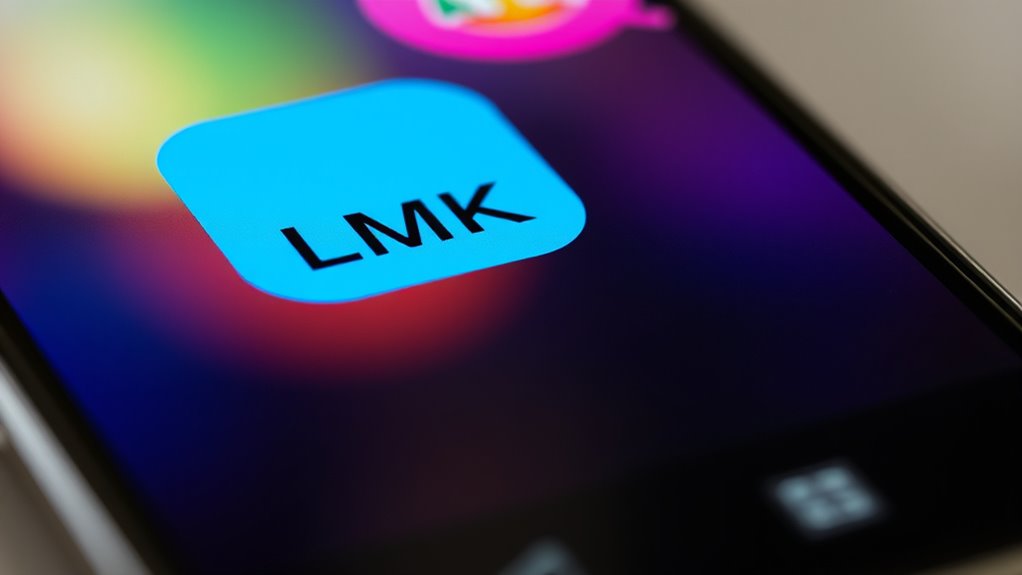
Understanding internet slang can seem challenging at first, but there are simple strategies to decode it quickly. Improving your digital literacy helps you stay connected and understand message context. Pay attention to common abbreviations and their meanings, as they often follow patterns. Keep in mind online etiquette by respecting others’ use of slang and asking questions when unsure. To get better, try these tips:
Learn to decode internet slang by observing, researching, and practicing online to stay connected confidently.
- Look up unfamiliar terms in trusted online dictionaries
- Observe how friends and peers use slang in context
- Use social media and forums to practice reading slang naturally
- Stay updated with trending abbreviations and memes
- Don’t be afraid to ask for clarification politely
- Understanding Gold IRA Rollovers can help you make informed investment decisions and better grasp financial terminology.
Mastering these skills helps you navigate online conversations confidently and enhances your digital literacy.
When to Use LMK in Your Messages

Knowing when to use LMK in your messages can help keep your conversations clear and efficient. This online slang is perfect when you need someone’s response or input quickly. Use LMK when you’re waiting on details, plans, or decisions. It fits into digital language trends that favor brevity and quick exchanges. To decide if LMK is appropriate, consider the context and relationship. Here’s a quick guide:
| When to Use LMK | When to Avoid LMK |
|---|---|
| Asking for a reply or confirmation | Formal emails or professional settings |
| Confirming plans or decisions | Serious or sensitive topics |
| Coordinating with friends | Conversations requiring politeness |
| Quick updates or check-ins | When clarity outweighs brevity |
| When leveraging AI tools for content creation | In situations demanding detailed or nuanced communication |
The Impact of Abbreviations on Formal Communication
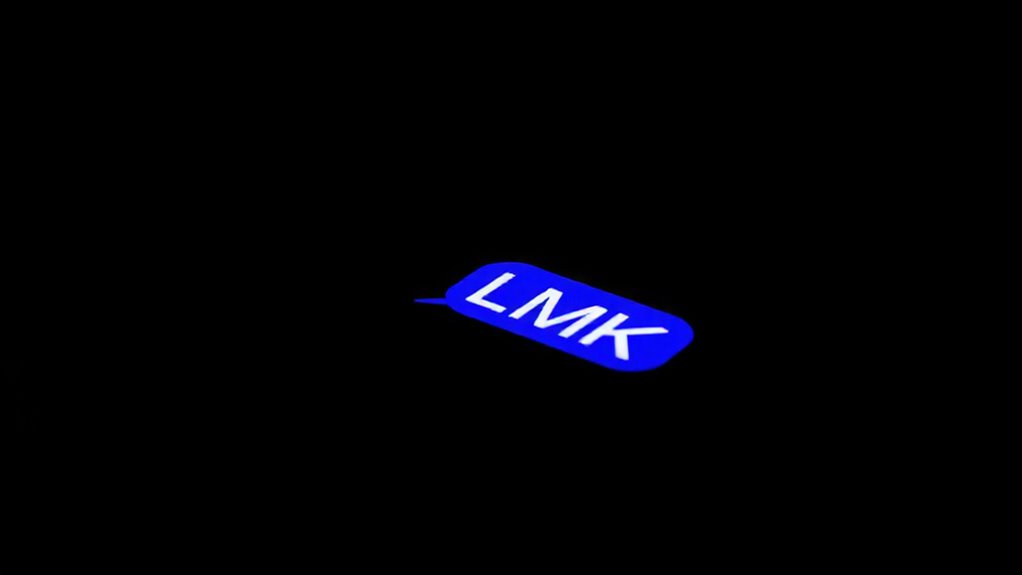
Have abbreviations like LMK affected the way we communicate in formal settings? Absolutely. In digital communication, abbreviations have blurred the lines between casual and professional language. Their abbreviation history shows they originated to save time but now impact clarity and professionalism. Here’s how they influence formal communication:
- Sometimes cause misunderstandings due to informal tone
- Can undermine credibility in professional messages
- Require careful use to maintain respect and clarity
- Encourage brevity but risk oversimplification
- Push organizations to update communication standards
- Proper usage of abbreviations is essential to uphold a professional image.
While abbreviations make quick exchanges easier, overusing them in formal contexts can harm your reputation. Knowing when and how to use abbreviations, considering their abbreviation history, is essential to balance efficiency with professionalism in today’s digital communication landscape.
Frequently Asked Questions
Is LMK Appropriate for Professional or Formal Communication?
You probably shouldn’t use LMK in professional or formal communication because it’s considered informal slang. It’s better to use more appropriate language that maintains a professional tone, such as “Please let me know” or “Kindly inform me.” Using clear, respectful language helps you come across as professional and respectful, especially in work emails or official messages. Stick to proper phrases to guarantee your message is taken seriously and maintains a professional tone.
Can LMK Be Used in Voice or Video Calls?
Research shows that 80% of communication is non-verbal, making tone important in calls. You can use LMK in voice or video calls to politely ask someone to inform you later. However, it’s best to stick with clear voice call etiquette and avoid shorthand like LMK in formal video call language. Keep your communication professional, and if you’re unsure, ask directly instead of relying on abbreviations during calls.
Are There Cultural Differences in Understanding LMK?
You’ll find that cultural interpretations and regional variations influence how people understand LMK. In some areas, it’s seen as casual and friendly, while others might view it as too informal or even confusing. Knowing your audience helps you decide whether to use LMK or opt for clearer communication. Be aware that in different regions, the meaning and acceptance of abbreviations like LMK can vary, so adapt accordingly to avoid misunderstandings.
How Does LMK Compare to Similar Abbreviations Like “Tmi”?
Ever wonder how LMK compares to similar slang abbreviations like TMI? Both are used in casual conversations, but LMK asks someone to “let me know,” prompting a response or decision. TMI, on the other hand, signals that someone is sharing too much information. While both are abbreviations for quick communication, LMK focuses on requesting info, whereas TMI indicates oversharing in conversation.
What Are Common Mistakes When Using LMK in Messages?
You often make mistakes with LMK when you lack clear context, leading to confusion about its meaning. To avoid this, make sure your message provides enough background so recipients understand you’re asking them to “let me know.” Overusing abbreviations like LMK without clarity can cause misunderstandings. Always consider the context and whether the abbreviation might be unfamiliar, helping your message stay clear and effective.
Conclusion
Now that you’ve unraveled the mystery of LMK, you’re like a traveler armed with a new map in the vast, bustling city of digital slang. As you navigate conversations, remember these abbreviations are your keys to quick, friendly exchanges. Use them wisely, like a skilled musician tuning their instrument, ensuring your messages hit the right note. With this knowledge, you’re ready to dance gracefully through the vibrant rhythm of online communication.









